
Invasive species cause problems for parks
It starts off innocently enough.
A tree looks beautiful with its red berries and seems perfect as a decorative plant. A pet snake is purchased when it’s young, cute and little. But things can quickly get out of hand, and suddenly these things don’t look so nice. This is the problem of invasive species.
Invasive species appear in every national park. While exotic, or non-native, species may migrate to other national parks, they are only considered invasive if they are not constrained by the natural factors that inhibited them in their native environment.
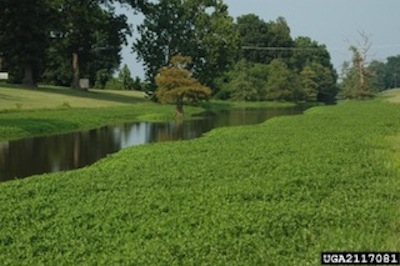 |
A Brazilian Pepper tree sporting its bright red berries. Birds gorge themselves on the berries, and then disperse the seeds (Photo courtesy of Larry Perez, South Florida National Resources Center, National Park Service). |
“An exotic species is any organism that has extended itself beyond its natural range, largely by humans,” said Larry Perez, Science Communications Liaison of the South Florida National Resources Center (a part of the National Park Service). “The species can be introduced intentionally or accidentally, and not every species transplanted this way goes out of control.”
“It’s those that do go out of control and escape cultivation that are problematic,” Perez added.
And, while some native species can be invasive, far more often the invasive species is exotic. Some of the major ones in Florida are the Brazilian Pepper (Schinus terebinthifolius), the Cuban tree frog (Osteopilus septentrionalis) and the Burmese Python (Python molurus bivittatus).
“The Brazilian Pepper was actually brought over primarily by ship as an ornamental,” according to Bob DeGross, Chief of Interpretation and Public Affairs at Big Cypress National Preserve. “For the longest time it was marketed as ‘Florida Holly’ and people believed it was a beautiful plant.”
This is far from the truth, as it was soon discovered. The plant invades fields, canal banks, roadsides and other areas by creating impenetrable thickets that restrict the growth of native plants. It also produces bright red berries (thus the reason for one of its nicknames—Christmasberry), which birds eat and then disperse over vast areas of lands, leading to a very quick spread of the plant. And getting rid of the Brazilian Pepper isn’t nearly as easy as it would seem.
| An example of infestation of the Brazilian Pepper (Photo courtesy of Randy Westbrooks, U.S. Geological Survey). |
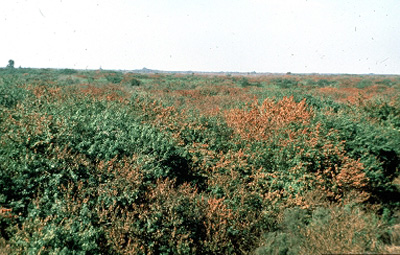 |
“We have crews that do hand removal and treat with herbicides,” DeGross said. “With the Brazilian Pepper the seed berries are so prolific that they hang out in the soil for a long time.”
“Fire stresses the tree, so we try a mechanical method of that,” added Perez. “However, methods of removal vary by organism. If you use fire on another organism, it might spread the seeds and allow it to grow very quickly.”
While the Brazilian Pepper is a threat to native species, invasive species aren’t limited to plants. Two nuisances in Florida are the Cuban tree frog and the Burmese Python.
The Cuban tree frog is the largest species of tree frog in North America, and is a voracious eater, preying on other native frogs, toads, and lizards. They secrete toxins that harm other wildlife who have not adapted to the toxins. A single Cuban tree frog can lay 4,000 eggs at a time, so the amphibians can spread quite rapidly.
“I don’t think there’s any way to control the Cuban tree frog,” Perez said. “It’s ubiquitous in South Florida. The best we can do is monitor the situation.”
“What’s interesting about the Cuban tree frog is how it is so adaptable,” he continued. “They fit into a little niche, in this case, urban environments, that other species don’t. They’re able to populate those areas better than native species can.”
“Every species has a niche that it survives in,” agreed DeGross. “Anytime you introduce something, that thing you introduce has to take up a niche and something else is forced out, which means it’s preyed upon and eventually disappears.”
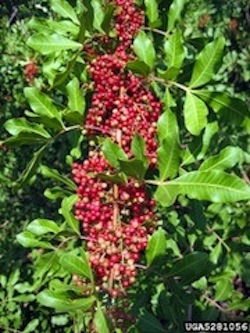 |
A Cuban tree frog poses for the camera (Photo courtesy of Trisha M. Shears). |
“In Big Cypress we do have some animals that can prey upon the frog, but it’s still a problem,” he said.
The frogs are attracted to electrical current, and have been responsible for blackouts in areas of South Florida. The easiest way of eradicating them is through hand removal, something with which the general public can help.
“We don’t want people to collect things that they may not recognize,” DeGross said. “If they are interested in assisting and eradicating, we want to make sure they do a little background study first so they know what they’re seeing. I think it is a good idea to capture those things and eradicate them.”
Another threat, especially in the Everglades, is the Burmese Python. These snakes are quite popular as household pets in Florida. Unfortunately, as the snakes grow in size, the owners no longer can care for them and, rather than euthanizing them, the owners release them into the wild.
| A close-up view of the Burmese Python (Photo courtesy of the National Park Service). |
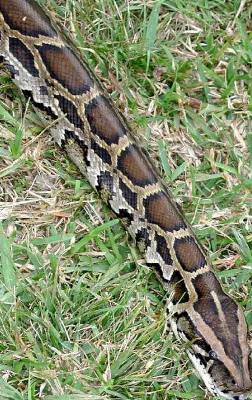 |
“Burmese pythons are extremely popular in the pet trade,” said Julian Lee, a retired UM professor and herpetologist. “Almost all pet stores sell them. When people can’t deal with them, they turn them loose, which has led to breeding in the Everglades. With organisms, nothing in their past prepares them for a predator like that, so invasive species are a present danger.”
“Within [the Everglades] we’ve had instances of Burmese Pythons,” Perez said. “They are the biggest nightmare we’ve ever had to deal with.”
As far as removing the Burmese Python, there doesn’t seem to be a commonly accepted method of doing so.
“With some species there are no good strategies for removal,” said Perez. “So we learn a management strategy as we go along. We’re figuring out trap strategies, and we’re using dogs as a way to help control them.”
While people unfamiliar with these species may not recognize them, they can still do their part to avoid spreading trouble.
“We try using education as a means of prevention,” Perez said. “The single best thing the general public can do is just prevent future problems by being good stewards of the animals and plants they maintain.”
“Never ever, under any circumstances, release an exotic species into an area that’s outside their geographical region,” said Lee. “It’s bad biology to release them outside of their range. It’s even a bad idea to release native species that have been in captivity, even if it’s in the region you initially found them. You may be introducing diseases and pathogens into geographical regions.”
DeGross noted how expensive invasive species can become, and suggested a nip-it-in-the-bud approach.
| Dr. Skip Snow in lab with Burmese python captured in Everglades National Park (Photo courtesy of the National Park Service). |
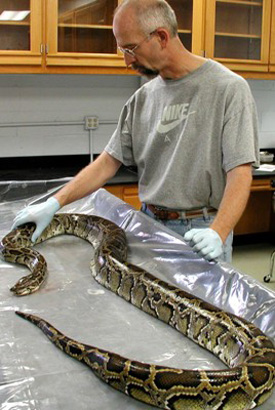 |
“Unfortunately, most non-native species are introduced to an area inadvertently through international shipping,” he said. “The effort to eradicate non-native species is a multi-million dollar effort annually.”
“The best way to eradicate is to just not start the problem,” he added.

Comments are Closed